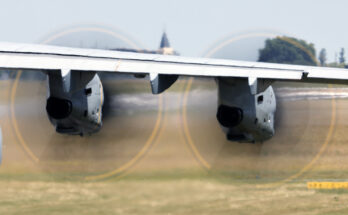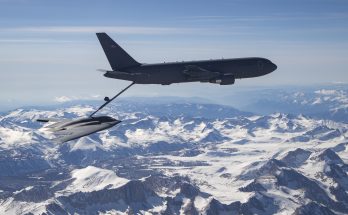The Swiss government has tapped two American-sourced solutions to meet the requirements of its Air 2030 program to replace the Swiss Air Force’s aging fleet of both F-5 Tiger and F/A-18 Hornet jet fighters and its ground-based anti-aircraft defense architecture by 2030.
#DécisionCF Le Conseil fédéral décide d’acquérir 36 avions de combat de type @thef35 et 5 unités de feu du système @RaytheonTech Patriot. #Air2030 https://t.co/LL6awYQVaZ pic.twitter.com/r2L0RNBAup
— VBS – DDPS (@vbs_ddps) June 30, 2021
For the new combat aircraft (Neues Kampfflugzeug, or NKF) requirement, the Federal Council has downselected the F-35A Lightning II fighter from Lockheed Martin. The F-35 beat out bids of the Eurofighter Typhoon, the Dassault Rafale, and the Boeing F/A-18E/F Super Hornet.
The Swiss government has selected the F-35 program for its New Fighter Aircraft competition. Read the release at the link below.
— Lockheed Martin News (@lmnews) June 30, 2021
In regard to the Bodengestutzte-Luft-Verteidigung (or BODLUV) requirement for a long-range surface-to-air defense system (DSA LP), the Patriot surface-to-air defense system from Raytheon Technologies won out over the Eurosam consortium’s SAMP/T system.
Funding for the combat aircraft is earmarked at CHF6 billion ($6.51 billion), while that of the DSA LP is fixed at CHF2 billion ($2.17 billion).
After failing to replace its F-5 fleet under the defunct Tiger Partial Replacement (Tiger Teilersatz, or TTE) program due to public disapproval of the procurement via popular referendum, Switzerland revisited a fighter acquisition under the Air 2030 program.
The government sent a proposal to Parliament for funding of the Air 2030 package, which was approved on December 20, 2019.
But concerns mounted that a rebooted effort would again be knocked down by popular referendum. Switzerland’s direct democracy model allows for voters to generate a plebiscite provided 50,000 valid and verifiable voter signatures, or eight of Switzerland’s 26 cantons (states within the greater federal state), call for one. For a neutral country that has not fought a war in 200 years, the idea of procuring expensive new-generation combat aircraft is considered an extravagance by opponents, who generally have little difficulty collecting the required signatures.
Worries that placing the country’s air defense capability before a referendum rendered Swiss national security and the nation’s armed forces at risk were put to rest when the Air 2030 proposal narrowly passed by fewer than 10,000 votes on September 27, 2020.
In its statement, the Federal Council cited several factors in its selection of the F-35, including efficiency, survivability, product support, and possibilities for cooperation. The F-35 did not receive the highest marks in the category involving direct offsets, for which the obligation to compensate 60 percent of the order value must be fully met within four years after final delivery.
For the long-range surface-to-air defense system, the Patriot was cited for effectiveness in comparison to the SAMP/T in terms of both engagement range and cost.
Switzerland intends to purchase 36 F-35A fighters and five Patriot Fire units. The Swiss Federal Assembly (bicameral parliament) must now approve the Federal Council proposal.

Forecast International’s Military Aircraft Forecast reports on fixed-wing military aircraft of all types – fighters, military transports, military trainers, and special mission aircraft – worldwide. Full coverage of leading programs such as the Lockheed Martin F-35 Joint Strike Fighter (JSF), the Dassault Rafale, the Saab Gripen, the Airbus A400M, the Beechcraft T-6, the Embraer Super Tucano, the Pilatus PC-21, and the Boeing KC-46A, among others. An annual subscription includes 42 individual reports, most with a 10-year unit production forecast. Product comes complete with four Market Segment Analyses, covering the markets for: Fighter Aircraft, Military Transport Aircraft, Military Fixed-Wing Trainer Aircraft, and Special Mission Military Aircraft. Pricing begins at $2,295, with discounted full-library subscriptions available. Click here to learn more.
Dan Darling is Forecast International’s director of military and defense markets. In this role, Dan oversees a team of analysts tasked with covering everything from budgeting to weapons systems to defense electronics and military aerospace. Additionally, for over 17 years Dan has, at various times, authored the International Military Markets reports for Europe, Eurasia, the Middle East and the Asia-Pacific region.
Dan's work has been cited in Defense News, Real Clear Defense, Asian Military Review, Al Jazeera, and Financial Express, among others, and he has also contributed commentary to The Diplomat, The National Interest and World Politics Review. He has been quoted in Arabian Business, the Financial Times, Flight International, The New York Times, Bloomberg and National Defense Magazine.
In addition, Dan has made guest appearances on the online radio show Midrats and on The Media Line, as well as The Red Line Podcast, plus media appearances on France 24 and World Is One News (WION).




